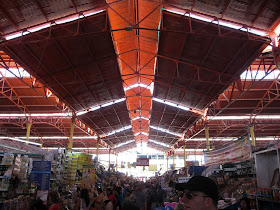Early the next morning we fly to the first real place we are visiting: Arequipa.
As we make our descent, we can see the morning fog lifting from the desert.
We land in Arequipa.
At 2335 meters above sea level, we will be acclimating to the altitude a bit.
Arequipa is sometimes called "The White City" due to the stone used in the colonial buildings. It is the second largest city in Peru
According to our guide, the city's name comes from the Quechua language "Ari qhipay" meaning, "Yes, stay."
On our way to the hotel, we get a brief look of the city, from slums on the edge to the old colonial buildings near the Plaza del Armas.
We arrive to our hotel. It is not a traditional U.S. hotel.
The first courtyard:
There is a strange decoration on the roof. I will explain this much later when we finally learn what it is.
The second courtyard
Inside our room we have a skylight.
And double doors out into the courtyard.
Settled into our rooms, it's time to explore the city a bit. The city is very hot and dry. It's important to drink lots of water.
We go to where we can view the valley with the volcano, El Misti, in the background.
We also walk around in the city on foot. There are few stoplights or stop signs at the intersections in Arequipa. The rule seems to be that whoever goes first is the one who gets to go first. All the roads are narrow and many are cobblestone. The streetways were built when the Spanish were here.
We go to a small stand where they sell some local medicinal plants and herbs. The first we see is called maca. It is a root that can be ground to a powder that is super dense in vitamins and minerals.
I purchase some coca leaves. They come with a mineral rock, which enhances and quickens the effect of the leaves. To chew, take a pinch of leaves (5 is good), place them green side up, and put just a small pinch of the rock on top. Fold them up and chew them and let them form a pulp in the mouth.
The coca leaf has a long history in the Andes as a medicinal herb and is also used in religious offerings. It's also made into tea and candies in addition to the straight leaf form. It has been used as an anesthetic and as a treatment for various ailments, including altitude sickness. This was my excuse for chewing it ;).
We walk to a church: San Jaun de Yanahuara. This was built in 1730. The designs are a mixture of both the Catholic religion and the native Andean religion. This was common as a way to introduce the Catholic religion to the Incans.
We then take a trip to the local market.
There's lots of fruit.
Olives.
The number I have heard of potatoes found in Peru varies between three and four thousand. Yes, thousand. So, of course there are potatoes in the market.
Homemade cheese. The leaf is to hold the shape as it's being made.
Sacrificial religious items. That is... well, was a baby llama.
After the market, we walk back to the Plaza del Armas, where there is a strike going on.
This church near the plaza was built in 1698.
We visit the site where the Jesuit Priest school once taught the native people. However, they were kicked out of the country in the lat 1700s. The building was originally built in the 17th century. The courtyard of the building is now a commercial center. The chapel itself is a vaulted dome with lots of color made from natural dyes. Photos are not allowed inside the chapel.
For lunch we eat at a place called Chicha.
They also have a skylight, but have a chandelier hanging from it.
The eating area was once a courtyard. Now there is a tarp to keep the weather out.
Salad and chupe de camarones. Delicious.
That afternoon we walk around the plaza.
After little sleep from the night before, we turn in around 6pm.

































No comments:
Post a Comment